2007 BCWWA Annual Conference Theme: Working Towards Sustainable Communities
Convening for Action in BC
“Working Towards Sustainable Communities” was the theme for the 2007 Annual Conference of the BC Water & Waste Association (BCWWA), held in Penticton. According to Jim Levin, BCWWA President, “This phrase captures a common element in our day-to-day work regardless of the kind of work we are engaged in. Fundamentally, most of what we do is tied to trying to overcome the challenges presented by our communities whether as a municipal employee, consultant or supplier. Events like this conference are opportunities to learn through the exhibits, technical presentations, demonstrations, tours and discussions with delegates. It is this sharing of experience that moves us toward creating better and more sustainable communities.”
Keynote Speeches Set the Stage
Keynote speakers for the conference were Dr. Tom Siddon, Chair of the Okanagan Water Stewardship Council, and the Honourable Barry Penner, Minister of Environment. To download Dr. Siddon’s speech, please click on this link to Water Stewardship is Everyone’s Business – Setting the Course for Change
In his prepared remarks, Minister Penner singled out the accomplishments of the BCWWA Water Sustainability Committee in delivering the Water Sustainability Action Plan for British Columbia through partnerships with his Ministry and others.
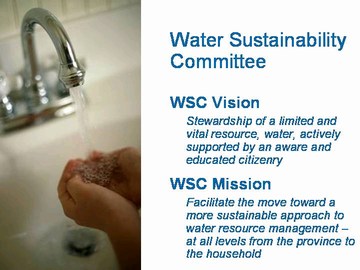
Water Sustainability Committee:
Within the BCWWA framework, the Water Sustainability Committee (WSC) is a broadly based roundtable of organizations that have a specific interest or mission in implementing the Water Sustainability Action Plan. The roundtable encompasses government organizations, non-government associations, the private sector, and universities. One of the criteria for membership is that individuals will feed back the WSC outcomes into their organizations.
 The WSC is providing the leadership, facilitation and organizational services necessary for successful program implementation. The Minister’s recognition of the WSC set the stage for a half-day Action Plan session within the main conference program, organized by the WSC in collaboration with the Green Infrastructure Partnership. In his prepared remarks, the Minister made the following observations:
The WSC is providing the leadership, facilitation and organizational services necessary for successful program implementation. The Minister’s recognition of the WSC set the stage for a half-day Action Plan session within the main conference program, organized by the WSC in collaboration with the Green Infrastructure Partnership. In his prepared remarks, the Minister made the following observations:
“As Minister responsible for Water Stewardship and Sustainable Communities, I place a high priority on fostering water stewardship and individual responsibility. By sharing information, promoting water awareness and supporting communities to integrate sustainable water management practices with local land-use planning and development, I believe we can develop a culture of water conservation across the province.”

“Under the umbrella of the Water Sustainability Action Plan, the BCWWA through the Water Sustainability Committee has established the Water Bucket website (www.waterbucket.ca), a resource-rich, interactive location for information about water sustainability in British Columbia. In addition, Convening for Action pilot programs in the South Okanagan, Vancouver Island and Greater Vancouver are promoting water-centric approaches to community planning and land development.”
Program Design – A Collaborative Effort
Titled Water Sustainability: Convening for Action in British Columbia, the Action Plan session comprised five cascading presentations that elaborated on the Minister’s message to delegates.
- Water – Choosing Sustainability for Life & Livelihoods— a co-presentation by Raymond Fung (Chair, Water Sustainability Committee) and Lynn Kriwoken, Director, Innovation & Planning Team, Water Stewardship Division, Ministry of Environment
- Convening for Action on Vancouver Island: Towards Water Sustainabiity — a co-presentation by Tim Pringle (Executive Director, Real Estate Foundation of BC) and Graeme Bethell (member of CAVI Leadership Team)
- Convening for Action in the Greater Vancouver Region: Celebrating Green Infrastructure— a presentation by Paul Ham (Chair, Green Infrastructure Partnership)
- Convening for Action in the South Okanagan: Water for Life and Livelihoods— a co-presentation by Ted van der Gulik (Ministry of Agriculture & Lands) and Meggin Messenger (Ministry of Community Services)
- WaterBucket – The Water Portal for British Columbia — a co-presentation by Michael Tanner (Chair, Water Bucket Website Partnership) and Lori Henderson (Senior Policy Advisor, Water Stewardship Outreach, Ministry of Environment)
The Water Sustainability Committee and the Green Infrastructure Partnership have developed a close working relationship, in part because the WSC is a member of the Partnership Steering Committee. “The WSC and Green Infrastructure Partnership collaborated to organize the Action Plan session because desired  outcomes for water sustainability and green infrastructure are common to both, and can be achieved through infrastructure standards that reflect a full and proper understanding of the relationship between land and water”, noted Kim Stephens (Program Coordinator for the Water Sustainability Action Plan), the Moderator for the Convening for Action session. The Convening for Action session attracted an audience totalling 130.
outcomes for water sustainability and green infrastructure are common to both, and can be achieved through infrastructure standards that reflect a full and proper understanding of the relationship between land and water”, noted Kim Stephens (Program Coordinator for the Water Sustainability Action Plan), the Moderator for the Convening for Action session. The Convening for Action session attracted an audience totalling 130.
The Green Infrastructure Partnership was formed in 2003 and is a consortium of four organizations. Under the Action Plan framework, its mission is to facilitate implementation of design with nature infrastructure practices and regulation province-wide. If we design with nature, then the water balance can be maintained or even restored over time.

Why We Are Convening for Action
The British Columbia landscape is being transformed by settlement and economic growth. “While the province has been experiencing enhanced social and economic well-being, the need to mitigate pressures on land and water resources has provided a driver for a ‘green infrastructure’ movement that is water-centric and is founded on a natural systems approach”, commented Kim Stephens.
According to Stephens, “Infrastructure design is changing. Cumulative benefits are achievable, one property at a time, through changes in the policies, programs, practices and standards that determine how land is developed and water is used. By implementing design with nature infrastructure practices and regulation, the ‘convening for action’ vision is that British Columbia will be well on the way to achieving water sustainability by 2010.”
The objective when ‘convening for action’ is to influence practitioners to learn about and use practices that better balance the necessary relationships of settlement activity and ecological assets in local and regional landscapes. Practitioners are defined as those whose professions, vocations and volunteer tasks relate to use and conservation of water, land and real estate.

Water – Choosing Sustainability for Life and Livelihoods
At the 2006 BCWWA Annual Conference, the Water Sustainability Committee organized a Mini-Summit on water stewardship and sustainability in the South Okanagan. This seminal event commenced the branding process within British Columbia for use of the phrase ‘water for life and livelihoods’ in order to focus people on what is at stake over both the short and long terms. The phrase conveys the fundamental principles of sustainability of natural systems in their own right and in relation to the health and well-being of people who benefit from the use of water for basic life needs and economic activity.

 This two-part presentation defined the relationship between the Ministry of Environment and the Water Sustainability Committee. In her part, Lynn Kriwoken addressed Challenges and Possibilities and emphasized that the Ministry of Environment views its partnership with the Water Sustainability Committee as an essential element in implementing the Ministry’s Water Stewardship Outreach Strategy. In his part, Ray Fung unveiled a new graphic that conceptualizes that the four areas of activity under the Action Plan umbrella. He also described what Convening for Action means in practice.
This two-part presentation defined the relationship between the Ministry of Environment and the Water Sustainability Committee. In her part, Lynn Kriwoken addressed Challenges and Possibilities and emphasized that the Ministry of Environment views its partnership with the Water Sustainability Committee as an essential element in implementing the Ministry’s Water Stewardship Outreach Strategy. In his part, Ray Fung unveiled a new graphic that conceptualizes that the four areas of activity under the Action Plan umbrella. He also described what Convening for Action means in practice.

According to Lynn Kriwoken, “Water is the piece that integrates everything that we care about. You will note that we are using the phrase water stewardship, not water management. Stewardship is about replacing self interest, dependency and control with service, responsibility and partnership.”
 Lynn Kriwoken quoted extensively from James Hoggan’s research on Communicating Sustainability. Hoggan believes that sustainability experts and the public are out of synch on this subject. According to Hoggan, the public has already worked through the issue of what sustainability means to a considerable degree. The gap that exists, or the disconnect between what people believe, and what they do, has to do with barriers defined by Hoggan as:
Lynn Kriwoken quoted extensively from James Hoggan’s research on Communicating Sustainability. Hoggan believes that sustainability experts and the public are out of synch on this subject. According to Hoggan, the public has already worked through the issue of what sustainability means to a considerable degree. The gap that exists, or the disconnect between what people believe, and what they do, has to do with barriers defined by Hoggan as:
- Mindset barriers:Participants describe a set of internal expectations and assumptions that often get in the way of their making more sustainability sound decisions. In particular, force of habit; consumerism and peer pressure to over consume; a sense of entitlement that we “deserve the good life”. Human nature, one person can’t make a difference, etc.
- Information barriers:Prices do not reflect real long term social and environmental costs. Product labels do not provide reliable information on products’ energy, ecological and social footprints. Measures used to assess performance – such as GDP – reinforce focus on short term economic factors. The way the media covers issues related to sustainability – or doesn’t cover them – doesn’t help public understand them.
- Trust barriers: Mistrust emerged as the most fundamental barrier to effective action on sustainability values. Businesses and government send mixed signals – say one thing and do another. Lack of accountability increases mistrust. Citizens don’t trust business to do the right thing and don’t think government is doing what it should. When citizens believe that others – especially leaders – cannot be trusted to do their fair share, they are less likely to take action themselves.
Lynn Kriwoken concluded her presentation by presenting the Province’s vision for water. She stated that: “We can only attain the vision through shared stewardship.”

“Stewardship is an obligation that we all have”, stated Ray Fung, “And the key to moving from awareness to action is to form partnerships. Partnerships provide a good way to share risks. The Water Balance Model is a prime example of spreading the risk by banding together. Municipalities invested $5000 each knowing that even if the project failed, there was no financial downside because $5000 is a small amount. On the other hand, the upside was substantial because we now have a value-added tool that no individual partner could have funded single-handedly.”
“Convening for Action is our mantra”, continued Ray Fung, “In a nutshell, we are 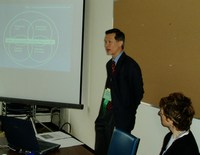 saying that we do not want to get together at conferences or wherever just to talk. When we gather, it is for a purpose. There must be an action item or an outcome. Our aim is to move from talk to action by developing tools, building capacity, and providing training.”
saying that we do not want to get together at conferences or wherever just to talk. When we gather, it is for a purpose. There must be an action item or an outcome. Our aim is to move from talk to action by developing tools, building capacity, and providing training.”
Fung then provided context for each of the three regional pilots for Convening for Action: “In the South Okanagan, we have helped bring a voice to water issues. In Greater Vancouver, practitioners working for local governments told us they did not want more documents that simply go on a shelf; rather, they wanted to network and share their experiences. On Vancouver Island, we have an ambitious program to bring people together and apply/adapt what we have learned in the Okanagan and in Greater Vancouver.”
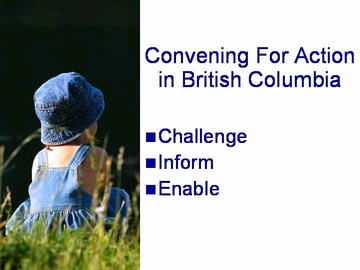
To Learn More:
To download a copy of the co-presentation by Lynn Kriwoken and Ray Fung, please click on this link to Water-Choosing Sustainability for Life and Livelihoods.
Convening for Action on Vancouver Island: Towards Water Sustainability
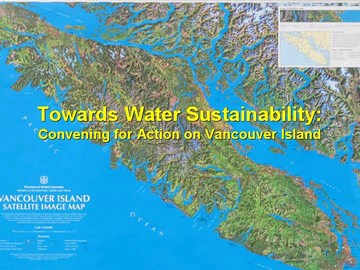
Convening for Action on Vancouver Island (CAVI) is a pilot program at a regional scale. CAVI will integrate with other groups, move ‘green value’ from concept to practice, and encourage the introduction of a ‘design with nature’ way of thinking into local government decision processes. Further, CAVI will play a leadership role in evolving a framework for water-centric planning that is keyed to accepting risk, rewarding innovation, and learning by doing. The emphasis will be on bringing together local government and the development community to change the way land is developed and water is used on Vancouver Island.
In this two-part presentation, Tim Pringle presented some attention-grabbing statistics to make the case for a fundamental shift in thinking so that settlement will be in balance with ecology. Graeme Bethell then described the origins of CAVI and elaborated on how CAVI will achieve its water-centric mission to achieve the vision for settlement in balance with ecology.

“Residents of growth communities think of themselves as being rural places, but people want urban services”, observed Tim Pringle, “Furthermore, the Province is now promoting resort municipality designations which would allow major  developments to be undertaken as local government areas. In short, this means nature is becoming commoditized.”
developments to be undertaken as local government areas. In short, this means nature is becoming commoditized.”
Pringle presented statistical data on the demand for land as measured by the total dollar value for all development permits. He compared the period 2001-2003 to 2004-2006 for each of the sub-regions that comprise Vancouver Island. Then he compared the Island with other regions in the province. Only the Northeast Region has been experiencing a faster growth in demand, and that is due to the oil boom in that region. “A critical issue is where to put the settlement so there will be the least damage to ecological assets”, conclude Pringle.

Graeme Bethell stated that CAVI is led by a team that represents both the  private and government sectors. “The genesis for CAVI was the ‘Meeting of the Minds’, a grass-roots initiative that started a communication network to address the issues facing the water and wastewater industry within the Vancouver Island region”, explained Bethell. “In moving towards water sustainability, we envision that developers that balance settlement and ecology will be rewarded. Because time is money, we believe that environmental environments can be paid for through money saved as a result of faster approval times”, added Bethell.
private and government sectors. “The genesis for CAVI was the ‘Meeting of the Minds’, a grass-roots initiative that started a communication network to address the issues facing the water and wastewater industry within the Vancouver Island region”, explained Bethell. “In moving towards water sustainability, we envision that developers that balance settlement and ecology will be rewarded. Because time is money, we believe that environmental environments can be paid for through money saved as a result of faster approval times”, added Bethell.
“Because we believe that Vancouver Island has all the ingredients in place for success, we believe that Vancouver Island will emerge as a water sustainability pilot for North America”, continued Bethell in referring to a potential West Coast Satellite Centre for Sustainable Urban Waters and Watersheds that would be linked to a 10-year research and development program that is being led by Northeastern University in Boston.
Graeme Bethell concluded his part of the presentation by listing upcoming events, including: a series of three events comprising field tours that is called Celebrating Green Infrastructure: Showcasing Innovation on Vancouver Island; a CAVI Consultation Workshop at the Gaining Ground Summit in June 2007; and a Mayors and Chairs Green Infrastructure Forum later in the year.
To Learn More:
To download a copy of the co-presentation by Tim Pringle and Graeme Bethell, please click on this link to Convening for Action on Vancouver Island: Towards Water Sustainability .
Convening for Action in the Greater Vancouver Region: Celebrating Green Infrastructure
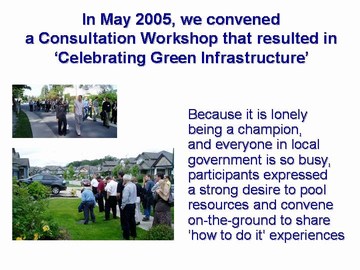
By pooling resources under a regional partnership framework for outreach and continuing education, local governments can leverage the efforts of their own staffs and develop a common understanding of issues and solutions. The goal in showcasing on-the-ground innovation is to build regional capacity through sharing of green infrastructure approaches, experiences and lessons learned as an outcome of ‘designing with nature’.
 In his two-part presentation, Paul Ham first explained how the 2005 Consultation Workshop for the Greater Vancouver Regional Engineers Advisory Committee resulted in complete reconfiguration of the work plan for the Green Infrastructure Partnership. He then elaborated on the experience of the City of Surrey in implementing the East Clayton Sustainable Community, with emphasis on what was done and what results were achieved in terms of reducing rainwater volumes and rates.
In his two-part presentation, Paul Ham first explained how the 2005 Consultation Workshop for the Greater Vancouver Regional Engineers Advisory Committee resulted in complete reconfiguration of the work plan for the Green Infrastructure Partnership. He then elaborated on the experience of the City of Surrey in implementing the East Clayton Sustainable Community, with emphasis on what was done and what results were achieved in terms of reducing rainwater volumes and rates.
According to Paul Ham, “The East Clayton Neighbourhood Concept Plan provided the first large-scale opportunity to ‘test’ a new approach advocated by Patrick Condon and others. This new approach, which is sometimes characterized as ‘the future is the past’, embodied a design with nature way-of-thinking about drainage.”

Looking back, it is sometimes hard to believe that almost a decade has passed since the City initiated the East Clayton plan”, added Ham, “With the passage of time, we tend to take the early innovation for granted. From my perspective, one aspect which really stands out about the East Clayton plan is the integration of sustainability objectives.”
since the City initiated the East Clayton plan”, added Ham, “With the passage of time, we tend to take the early innovation for granted. From my perspective, one aspect which really stands out about the East Clayton plan is the integration of sustainability objectives.”
Paul Ham also announced that the Green Infrastructure Partnership and the Greater Vancouver Regional District are proceeding with the 2007 Showcasing Innovation Series, the second year of the program.
To Learn More:
To download a copy of his presentation, please click on this link to Celebrating and Showcasing Innovation in the Greater Vancouver Region .
Convening for Action in the South Okanagan: Water for Life and Livelihoods
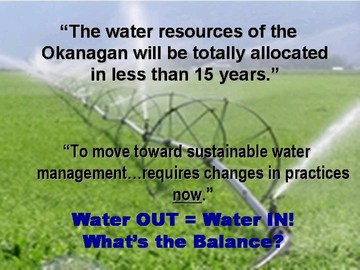
Within the next 10 to 15 years it is projected that the available water in the Okanagan Basin will be fully allocated. At the same time, agricultural development is also expected to increase, with potential growth in the grape and wine sector leading the way. Also, the region will continue to experience both the benefits and consequences of climate change – that is, a longer growing season and changes in form and pattern of precipitation and runoff, respectively. The purpose in ‘convening for action’ is to build regional capacity and understanding of what Water OUT = Water IN means in the context of a Regional Growth Strategy and its goals.
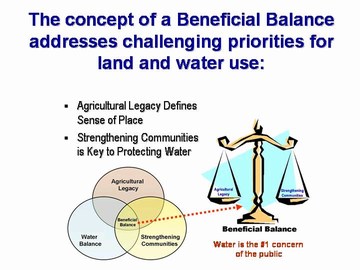
Everything is connected, and how we develop land determines how water is used  and how water runs off the land. Because water has been identified as the #1 concern of the public, the South Okanagan Regional Growth Strategy is a provincial pilot for advancing the water balance way-of-thinking and acting. According to Ted van der Gulik, “The Steering Committee for the South Okanagan Regional Growth Strategy also decided that it will apply the concept water for life and livelihoods to promote a water-centric approach to social, economic and environment sustainability over the short and long terms.”
and how water runs off the land. Because water has been identified as the #1 concern of the public, the South Okanagan Regional Growth Strategy is a provincial pilot for advancing the water balance way-of-thinking and acting. According to Ted van der Gulik, “The Steering Committee for the South Okanagan Regional Growth Strategy also decided that it will apply the concept water for life and livelihoods to promote a water-centric approach to social, economic and environment sustainability over the short and long terms.”
The mind-map provided by Water for Life and Livelihoods is ‘borrowed’ from work done in the United Kingdom, where basin plans are being prepared in accordance with the European Community’s ‘water policy directive’. This directive calls on all member countries to prepare water management plans at the river basin scale to guide area and sector-based water management strategies. The phrase conveys the fundamental principles of sustainability of natural systems in their own right and in relation to the health and well-being of people who benefit from the use of water for basic life needs and economic activity.

Water-centric planning considers the amount of water available, the amount of water needed, innovative efficiency strategies, the quality of water leaving an area, how rain and snow water are managed, and the impact on the natural environment. Implementation of integrated strategies and solutions ultimately requires integration of missions, mandates and accountabilities of participating agencies. In his presentation, Ted van der Gulik elaborated on the Agricultural Component of the Okanagan Water OUT = Water IN Management Model that is now under development under the aegis of the Okanagan Basin Water Board.

To Learn More:
To download a copy of this two-part presentation, please click on this link to Convening for Action in the South Okanagan – Water for Life and Livelihoods.
WaterBucket: The Water Portal for British Columbia
Education can play an important role in facilitating change. Education increases our capacity to make informed decisions and to act effectively in addressing environmental and development issues. This education and knowledge needs to reflect priorities in water stewardship, with strong linkages between programs, collaborating provincial and federal agencies, citizens of all ages and local communities.
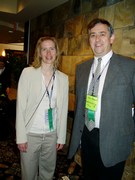 In this two-part presentation, Mike Tanner provided an overview of what the Water Bucket Website Partnership believes it can accomplish through this online medium. Lori Henderson then described how the Water Bucket is a prime example of using outreach to promote the move from awareness to action.
In this two-part presentation, Mike Tanner provided an overview of what the Water Bucket Website Partnership believes it can accomplish through this online medium. Lori Henderson then described how the Water Bucket is a prime example of using outreach to promote the move from awareness to action.
According to Mike Tanner, “What makes the website distinctive is that it has three dimensions. It is a news magazine for raising awareness of BC Success stories. It has a growing library of information resources on the BC experience and it houses ‘made in BC’ tools for use by practitioners on-the-ground. It will facilitate networking and the sharing of knowledge and expertise, support efforts to promote water conservation and stewardship and help convert that information into action.”

“The Water Bucket is not one entity”, added Mike Tanner, “Rather, information is coming from a large group of contributors that we call communities-of-interest. With the launching of the Small Community Infrastructure Community-of-Interest at this BCWWA Conference, we now have a total of nine. Each has its own identity, yet there is overlap because everything is connected.

The focus of the presentation by Lori Henderson was on how outreach can play a strategic role. She explained that once you connect with people and their values, then you are in a position to motivate and inspire them to change behaviour.
“The takeaway message from my part of this presentation is that outreach is more than brochures”, stated Lori Henderson. “Outreach is an important tool to foster shared water stewardship and water-centric planning. The Water Bucket Partnership is one that is critical to achieving the Province’s vision — water for BC: safe, sustainable and valued by all”, concluded Henderson.
To Learn More:
To download a copy of the co-presentation by Mike Tanner and Lori Henderson, please click on this link to Water Bucket – The Water Portal for British Columbia .


